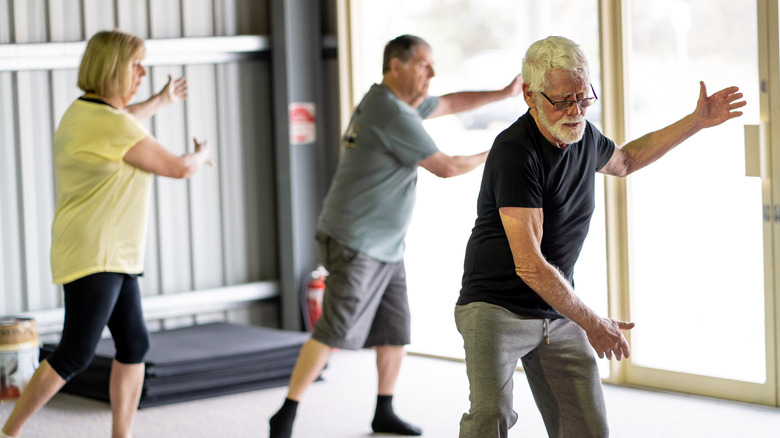Reduce Your Risk Of Falling With This One Easy Exercise
While exercise for young adults might have goals such as losing weight or looking good at the beach, those goals change as you get older. Strength training is particularly important for older adults because they lose muscle more quickly. This puts them at a higher risk for falls, according to the Centers for Disease Control and Prevention. Falls are particularly problematic for older adults because a broken bone (such as a hip) can lead to serious disability or other problems. It could also result in death. The CDC recommends strength training using weights or resistance bands at least twice a week.
In addition to a strength training program, you can do some basic strength training exercises at home just by using a chair. Chair exercises can move blood throughout your body and maintain the fluidity of your joints (per WebMD). If you're at a low risk of falling, Johns Hopkins Medicine suggests exercises such as the sit-to-stand exercise to reduce your risk of falling in the future.
The sit-to-stand exercise
For the sit-to-stand exercise, you'll need a chair that's not going to slide or roll around. The seat should be low enough for your feet to be flat on the floor. If possible, have a desk or stable counter nearby to help stabilize you as you stand up. You can also use the arms of the chair if standing up is difficult for you.
Shift to the front edge of the chair and lean slightly forward. While pressing your feet into the floor, feel your glutes and core engage as you come to standing. Slowly sit back down and do 10 more reps. Practice this exercise twice a day until you can easily stand up without using your hands. When this gets easy, find some light weights to hold in each hand to provide a little more challenge and instability as you stand up (per Johns Hopkins Medicine).
Those who have a high risk of falling, such as people who need assistance standing up on their own, should consider seeing a physical therapist to improve their balance and strength.
Other fall prevention exercises
Closing the Gap Healthcare also suggests strengthening the upper body to help keep you stable and prevent falling. While sitting in your chair, raise your arms overhead and reach as high as you can. You can use small weights to advance this exercise. To improve the mobility in your shoulders, extend your arms out to your sides and make 10 large circles in one direction. Repeat, going in the opposite direction. To prevent weakness in your grip strength, practice opening your fingers wide apart and then closing them into tight fists. Hold for five seconds and repeat.
The National Institute on Aging says that you can prevent falls by including some endurance exercise such as swimming, biking, or brisk walking. You can also help build strength and endurance if you live in a hilly area or a place with a lot of stairs. Yard work and dancing are also activities that can improve your circulation.
Improving your balance can avert falls. Practice standing on one foot while holding onto the back of a chair. Hold for 10 seconds, then rest. Repeat 10 to 15 times before working the opposite leg. You can make this exercise more advanced by trying to hold onto the chair with one hand, then no hands. Mindful exercises like Tai Chi can build strength while also working on balance as you move slowly through several movements.



